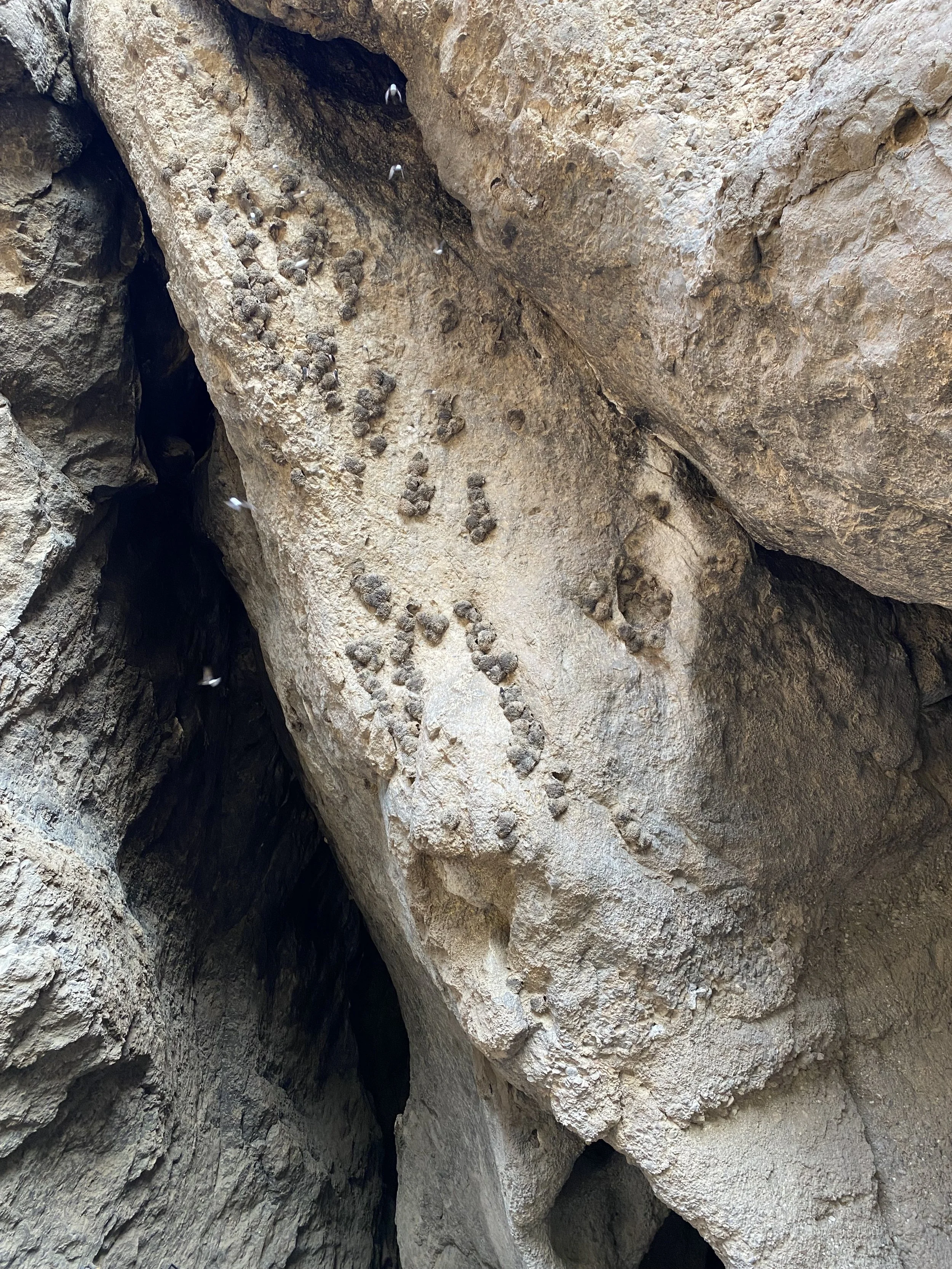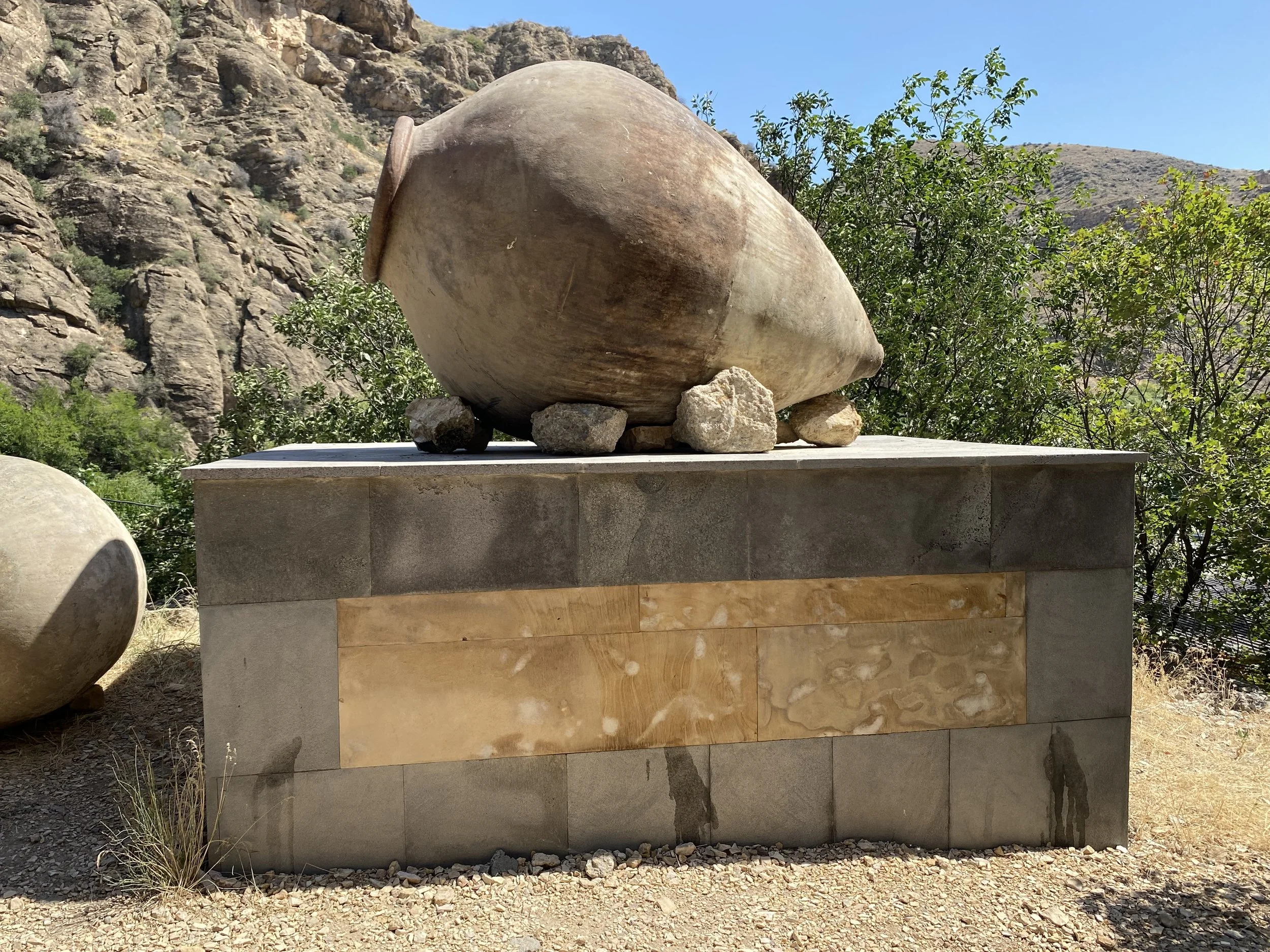Areni-1, Cave of Mysteries
Welcome to our premier archeologica site. What we found here takes the region back to the times of the arly man. The oldest known shoe, now on display in the History Museum of Armenia in Yerevan, was found at the entrance to this cave. We have also discovered the oldest known winery in this location, as well as evidence of human sacrifice and all many of early-human industry. Evdence of textiles, weaving, jewelry, and wine-making were all discovered within this cave.

Welcome to
The Cave of the Birds
Man has lived in this cave for a very long time and we have found layers upon layers of strata from different times in history. The cave has gained its name from these Crag-Martins that nest at the entrance to the cave.
Dated to 4300 BCE, the finding of this shoe placed this cave at on of the oldest and best preserved early human sites. We still have plans to keep this an active dig site. Donate today to help fund this important work!
The Cosmic Vessel was found in the cave near three human skulls, thought to be sacrifices.
Rendering of the design painted onto the Cosmic Vessel. We believe that this is a depiction of a single day in history, a solar eclipse that happened sometime around 4077 BCE.
April 1, 4014BC
On the Cosmic Vessel
Co-Authors: Boris Gasparyan, Artur Petrosyan, Michael Gfoeller, Rene Torres
In the course of archeological excavations conducted in the Areni-1 cave in Armenia since 2007, a large ceramic vessel was discovered that represents one of the oldest and most complete astronomical documents to survive from antiquity. The vessel was discovered intact and in situ, in locus 40 of section M17 in Trench 1 of the cave. It has the same shape as a traditional Armenian wine-making jar, known as a karas. However, it appears to have been used instead as a ritual vessel. Its surface is covered with drawings that seem to contain both mythological scenes and astronomical information, including an early form of mathematical notation. The drawings contain the earliest known depiction of a solar eclipse, as well as notation that seems to encode both the Metonic and the Saros cycles, used in ancient astronomy, as well as a lunisolar calendar of 365 days. The jar, which we have named the Cosmic Vessel, has been dated to the end of the 5th millennium BC by carbon-14 dating. Comparison of the astronomical drawings on its surface with computer reconstructions of the ancient night sky at the location of the Areni-1 cave indicate that it records an solar eclipse that took place on April 1, 4014 BC.
The Cosmic Vessel is made of red clay decorated with black pigment. Its surface is covered with a complex design that reflects mythology, mathematics, and astronomy. It appears to be a very early example of abstract symbolic notation, and thus an early form of writing as well. Some of the elements of the Vessel’s design seem to be mythological in nature, involving combat between snake dragons and horned mountain sheep or goats. We interpret this as a battle between order and chaos, or between good and evil, with the sheep representing the forces of good and the snake dragons the forces of evil. Such myths are found all over the world and are of great antiquity.
Most of the design’s elements seem to encode astronomical information dealing with the calendar, the prediction of eclipses, the relative locations of celestial bodies, and the overall structure of the universe. At the center of the design is a black sun. Its corona is visible, and several stars can be seen very near to it. It appears to be a depiction of a solar eclipse. During such an eclipse, the sun appears to turn black, its corona is visible, and stars can be seen quite close to the solar disc that are normally obscured by the brightness of the sun.
The Carbon-14 dating of the Vessel suggests that the design on its surface represents an eclipse that took place at the end of the 5th millennium BC. The Cosmic Vessel thus represents the oldest known depiction of a solar eclipse. Previously, the oldest known depiction of a solar eclipse was a series of petroglyphs discovered at Loughcrew, Ireland, which seem to record a solar eclipse dated to 3340 BC.
We have used astronomical computer programs to analyse the image of the sky shown on the surface of the Vessel. We paid particular attention to a feature resembling the image of the Pleiades, located to the left of the sun, and immediately adjacent to the moon. We also noted a large star depicted to the right of the sun. We hypothesised that it represented the planet Jupiter. The Pleiades played a crucial role in many ancient calendars. Their rising in the Spring and Autumn announced the time for planting and harvesting crops. As the Greek poet Hesiod wrote circa 700 BC:
Πληιαδων Ατλαγενεων επιτελλομεναων αρχεσθ αμιτου αροτοιο δε δυσομεναων
“When the stars of the Pleiades, daughters of Atlas, arise, then begin the harvest, but plough when they sink away.”
Jupiter, of course, is one of the brightest objects in the sky after the moon. It was universally considered in ancient cultures to represent a divine being, often a god. Our analysis showed that the locations of the Pleiades, Jupiter, and the constellation Taurus on the Vessel match the positions of the same celestial objects in the sky at Areni during the solar eclipse of April 1, 4014 BC. Of course, during a solar eclipse, the sky briefly turns black and the stars and planets are clearly visible, as at night. This date are fully consistent with the Carbon-14 dating of the Cosmic Vessel.
The degree of correspondence between the drawings on the Cosmic Vessel and the computer-aided reconstruction of the sky during the solar eclipse of April 1, 4014 BC is remarkable. As can be seen from the following illustrations, both images show the Pleiades to the left of the sun, the constellation Taurus beneath the sun, and the planet Jupiter to the right of the sun. There is one difference: in the drawing on the Vessel, the place occupied by the bull in the constellation Taurus (“taurus” means “bull” in Latin) is taken another powerful, horned animal, by a long-horned mountain sheep. Drawings of such sheep are common in Armenian petroglyphs of this period.
The presence of a constellation on the Cosmic Vessel is hardly surprising. There is abundant evidence that the Bronze Age inhabitants of the Armenian Highlands were well aware of the constellations, as noted by S. B. Petrosyan in a 1987 article entitled “The Oldest Petroglyphs of Armenia” (Древнейшие петроглифы Армении). As Petrosyan noted, numerous sites were identified in the Gegham mountain range of Armenia where the images of stars, planets, and constellations were carved into stone outcroppings as early as 2000 BC.
It is also remarkable that the ancient artist who painted the design on the Cosmic Vessel chose to place the sun at the center of the known universe. The ancient Arenians must have been very good astronomers indeed if they believed this to be true. If they reached this conclusion through careful observation of the night sky, they did so almost 4000 years prior to Aristarchus of Samos, the 3rd century Greek astronomer who proposed the first heliocentric model of the universe. How might this have been possible? Through the precise observation of lunar eclipses. This was the method used by Aristarchus, who, like the Arenians, relied upon naked-eye observation in studying the heavens.
We have also attempted to confirm the date of the solar eclipse drawn on the Vessel by using the Saros cycle, an astronomical technique used by ancient Babylonian and Greek astronomers to predict eclipses. The Saros cycle is the period of slightly more than 18 solar years that separates an eclipse from the next. Each cycle consists of 19 “eclipse years,” and each eclipse year in turn contains two eclipses. (An eclipse year is shorter than a solar year, averaging 346.6 days.) Thus, a Saros cycle contains 38 eclipses in total.
A full Saros cycle period consists of 18.029 years. One Saros period after a given eclipse has occurred, the Sun, Earth, and Moon will return to an eclipse alignment and another eclipse will occur. A succession of three Saros cycles, a period of 54 years and 33 days, is called an Exeligmos cycle. One Exeligmos after a given eclipse, another eclipse will occur, and at the same or similar location and time. The Saros cycle was built into the design of the Antikythera Mechanism, the oldest known astronomical computer, dated to the 2nd century BC. It can be used to predict lunar eclipses as well as solar eclipses.
The exact dates of relatively few solar eclipses are known from ancient history. One of them is the solar eclipse that occurred in the Kingdom of Georgia on May 6, 319 AD. Armenia and Georgia are located immediately next to each other in the Southern Caucasus. An eclipse seen in Georgia would almost certainly be visible in Armenia. Indeed, the territories of both states overlapped at various points in history. Historians note that a total solar eclipse was visible in Georgia on May 6, 319 AD. Using the Exeligmos cycle, one can determine the timing of previous eclipses with acceptable accuracy. By this calculus, solar eclipses would have occurred in the Caucasus region in the Spring of 4008 BC and 4116 BC, some 79 Exeligmos cycles prior to the eclipse in 319 AD.
The difference in the date yielded by the Saros method and that produced by astronomical computing is probably due to small fluctuations in the movements of the sun, moon, and earth over long periods of time. Even so the difference between the two dates is merely 6 years, over a span of six thousand years. Both the Saros date and the computer-generated date are consistent with the Carbon-14 dating of the Vessel.
Our analysis is bolstered by the fact that the complex geometrical design painted on the Vessel seems to encode the Saros cycle itself. The center of the design is surrounded by two concentric rings of symbols. The design’s outer ring is composed of 38 broad wedges, alternating in color between black and red. These wedges seem to represent the 38 eclipses that will occur in a given Saros cycle.
Why were the Arenians interested in solar eclipses? A solar eclipse would have been the most frightening natural phenomenon that ancient people knew. Nothing was more frightening than the idea that the sun might burn out, or be consumed by the powers of evil and darkness. By understanding the art and science of using the Saros cycle to predict eclipses, the ancient astronomers of the Areni-1 cave could claim that they understood and in a sense controlled the most awesome of the mysteries of nature and the spiritual realm.
The 38 wedges in the Vessel’s design could represent another key aspect of ancient astronomy. Ancient astronomers in many cultures were aware that it takes 19 years for the phases of the moon to occur once again at the same time of the solar year. This period of time is known as the Metonic cycle, after its official discoverer, the astronomer Meton of Athens, who lived in the 5th century BC. However, the Metonic cycle seems to have been known in different ancient societies at least as far back as 2000 BC. Our discovery of the Cosmic Vessel indicates that it may have been known far earlier, during the Chalcolithic period. The Metonic cycle was also called the “Enneadecaeteris” in Ancient Greek, meaning “nineteen years.” Like the Saros cycle, it was programmed into the Antikythera Mechanism.
Why would the ancient Arenians have cared about the Metonic cycle? The answer lies in their need for a reliable means of keeping track of time. Lacking clocks, watches, and telescopes, they relied upon precise, naked-eye observation of the cyclical movements of the sun, moon, planets, and constellations to track the seasons and count the years. It was extremely important for ancient peoples to know when to plant and harvest crops, when the Spring would begin, and how much longer it was until the Winter returned. Using the Metonic cycle, they could have devised a highly accurate lunisolar calendar, as did the ancient Greeks, Babylonians, Hebrews, and Egyptians.
There is additional evidence that the Cosmic Vessel encodes a sophisticated lunisolar calendar. The inner circle of its design is divided into 60 slices of identical size. Most contain a varying number of black dots, although 12 wedges are empty. The total number of these dots is 365. It is very likely that each slice represents one day of a 60-day month. Several ancient calendars were divided into six months of 60 days, with an additional “thirteen month” of five days added on to round out the year. The fact that the total number of dots in the 60 slices equals 365 suggests that the Armenians knew that the correct number of days in the year.
Another aspect of the design supports this line of reasoning. To the right of the sun is a drawing that resembles a double helix. It is reminiscent of the path traced by retrograde planetary motion. Within the three chambers of the helix are three rows of dots. The first row contains three dots, the second three again, and the third five. We believe that this element of the design has great significance. The first two rows of dots probably represent the six months of the year, while the final row of five dots probably represents the five intercalary days needed to complete the year.
Taken together, all these aspects of the Vessel’s design appear to encode a lunisolar calendar as accurate as that introduced by Julius Caesar at Rome 4000 years later.
The Cosmic Vessel is one of the most unique and valuable discoveries to have emerged in the field of archaeoastronomy. It contains the oldest known depiction of a solar eclipse. It also tells us that the civilisation that inhabited the Areni-1 cave in the Chalcolithic period had developed a remarkably advanced understanding of astronomy and timekeeping over six thousand years ago. They possessed an accurate calendar. They knew about the Metonic and Saros cycles and could predict solar and lunar eclipses. They knew about constellations and the Zodiac, and they made precise observations of the sky. They may even have deduced from their observations of lunar eclipses that the sun was the center of the observable universe, nearly 4300 years before the Greek philosophers at the Library of Alexandria reached the same conclusion. These conclusions suggest strongly that the origins of astronomy in the Armenian Highlands lies even further back in history, in the Neolithic, Mesolithic, or Palaeolithic period.










